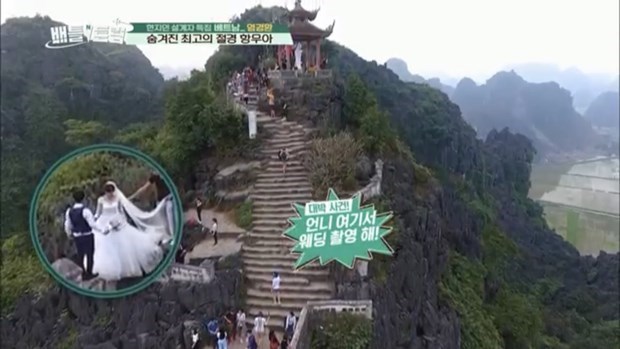 |
|
The Mua cave is viewed from above
|
Many famous and beautiful landscapes of Vietnam such as Phong Nha Ke Bang in the central province of Quang Binh, Ha Long Bay in the northern coastal province of Quang Ninh, and Trang An Landscape Complex in Ninh Binh have appeared on the world blockbusters, such as "King: Skull Island".
When the heat of "King: Skull Island" cooled down, the popular Korean TV show Battle Trip, with the participation of the two stars Eun Kyung Ahn Sun Yeong, chose the Mua and Thien Ha caves of Ninh Binh as its filming locations.
Eun Kyung and Ahn Sun Yeong could not hide their astonishment at the majestic scenery of Vietnam. The Korean citizens also left countless comments praising Vietnam’s beautiful landscapes.
Thien Ha cave
As a famous landscape in the former capital of Vietnam, Thien Ha cave is located in Mount Tuong - a mountain of Trang An range, which was considered a wall guarding the Hoa Lu citadel under the reign of Kings Dinh Tien Hoang and Le Dai Hanh.
 |
|
Inside the Thien Ha cave (Photo: VNA)
|
The cave is about 700m in length with two main areas: the 200-m dry cave and 500-m water cave. Tourists can enjoy the spectacular scenery inside – a fanciful world of unique stalagmites and stalactites.
The cave covers 12,000 sq.m, equivalent to the area of Sung Sot cave in Ha Long Bay.
According to US experts, the stalactite system in Thien Ha cave is still "alive" and in a development process.
In 2008, local archeologists discovered traces of ancient Vietnamese people living in the cave. Now, it has become a new tourist attraction in Trang An.
Thien Ha cave has added further variety to the tourism maps of Ninh Binh and Vietnam in general. In a bid to attract more tourists from both at home and abroad, the local authorities plan to diversify tourism services, such as homestays and community-based tourism.
Mua cave
Besides popular tourism spots like Trang An, Tam Coc or Bai Dinh pagoda, Hang Mua (or Mua cave) is a place that tourists should not miss when visiting the picturesque land of Ninh Binh.
It has been popular to domestic and foreign visitors thanks to the picturesque scenery of the surrounding area seen from its top.
The Mua Cave Complex - an area composed of intricate cave systems and limestone mountains - is located at the foot of Mua mountain within the eco-tourism area of Ninh Xuan commune in Hoa Lu district.
 |
|
'Great Wall' of Vietnam in a video clip by the RoK (Photo: VietnamPlus)
|
The centre of the complex features a crystal moss-green coloured human-made lake, surrounded by rows of trees.
Legend has it that the Tran Kings used to visit the area to watch the imperial maids sing and dance, giving the area its name, Mua or ‘dancing’.
There is a rocky hill dotted with nearly 500 steps leading to the top. A winding road running around the mountain leads to the top, which is covered by towers, making it look like a miniature Great Wall. Two sides of the road are decorated with sophisticated stone statues of dragons and phoenixes that were built in the Tran Dynasty (1225-1400)’s artistic style.
Mua cave itself is not impressive, but panoramic views from the peak above. With absolute greenery on all the sides, visitors can see the rocky hills grouped leading up to the horizon, with the river navigating in between. They will feel so tranquil when they sit on a rock at the top.
Tourists to this place often try to conquer the peak of the mountain from where it could bring them up to the one of the most iconic views in Vietnam - a panoramic view of scenic limestone mountain ranges and paddy fields. In particular, to the west is the Ngo Dong river winding through Tam Coc, the other sides afford a view of lush rice fields.
Visitors should not miss Mua cave when visiting Tam Coc – Bich Dong. Climbing to the top of the mountain, they will see the ancient capital of Hoa Lu, which is solid and beautiful, and will understand why this place was chosen as the capital of the ancient Vietnam.
In an interview granted to Vietnamplus, Hoang Thanh Phong, Deputy Director of the provincial Department of Tourism, said besides ecological and spiritual tourism, Ninh Binh will focus on developing cave tourism products in the coming time.
Ninh Binh boasts than 230 caves, of which over 60 percent are water ones - a unique tourism product of the locality.
 |
|
|
"We have been focusing on exploiting cave tourism, especially those in the Trang An Landscape Complex – the UNESCO-recognised world cultural and natural heritage”, he affirmed./. VNA
 The Mua (Dancing) and Thien Ha (Galaxy) caves in the northern province of Ninh Binh were introduced in Battle Trip – a famous TV show of the Republic of Korea (RoK).
The Mua (Dancing) and Thien Ha (Galaxy) caves in the northern province of Ninh Binh were introduced in Battle Trip – a famous TV show of the Republic of Korea (RoK).